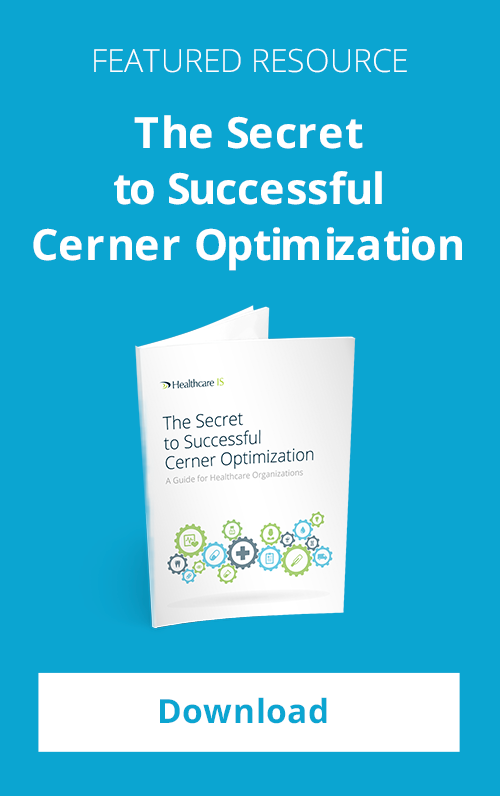Many organizations that go live with Cerner find that significant improvements are still needed to realize the full benefits of the platform. Thorough training on the new tools that begins before they go live can be essential to maximizing the value of the platform, but tweaking the system itself may improve performance as well. By pairing training with a careful optimization process it’s possible to prevent clinical work from being thrown off-balance by the platform, which may frustrate end-users throughout the organization.
What does a highly optimized Cerner platform look like? It’s different for every hospital, so many choose to create milestones related to their own meaningful use standards. Others have their own internal metrics to judge performance. Implementation is the just beginning; improving and refining your tools remains an ongoing process.
Almost every element of a Cerner platform can be optimized to improve performance, including electronic health records (EHR), computerized physician order entry (CPOE), and clinical decision support (CDS). The goal of the process is to adjust your tools until they reach the point where they significantly benefit patient care and improve clinical workflows, operations, and billing.
To better chart where your organization stands on the path to optimization, it’s helpful to understand the ways in which an optimized Cerner platform can impact patient care.
Workflows That Improve Ease of Use
Optimizing your Cerner platform can improve workflows throughout the hospital. Less time is spent re-entering patient information, since it is easily accessible through the EHR system. Patient intake is improved. Labs, radiology, and other diagnostics are ordered electronically, minimizing the possibility of errors or delays. Due to the connectivity between EHR and testing sites, results are linked to the patient's record almost immediately so hospital staff have rapid access to them.
All of these workflow changes can improve the speed and accuracy in which hospitals provide patient care. After the initial learning period associated with the launch of EHR and related systems, an optimized Cerner platform should help support staff in reaching greater efficiency and speed in diagnosing and treating patients.
Systems that are not yet optimized may suffer from slowdowns in many or all of these processes. For example, the ordering process may be broken, resulting in time consuming workarounds. Physicians may have to click through numerous irrelevant alerts in a CPOE interface. It’s often valuable to call in outside resources like vendor support or consultants to optimize Cerner systems that still have problems like this.
A Significant Reduction in Errors
Ideally, the Cerner platform will allow a hospital to track a patient’s medication history and allergies, and automatically check for conflicts when ordering new medications. CPOE helps to ensure that orders by clinicians are easily accessible, eliminating confusion and speeding up the process. CDS, in combination with EHR data, can help prevent drug-to-drug and drug-allergy interactions. One hospital saw a 60% decrease in near-miss medication errors after adopting an EHR platform.
Without optimization, a CDS system may deliver alerts at inopportune times and frustrate clinicians. The resulting “alert fatigue” may cause clinicians to click through alerts and undermines their effectiveness in CDS. Difficulties adjusting to CPOE can lead hospital staff to create informal workarounds that can significantly increase the rate of errors.
An optimized platform can also reduce instances of hospital-acquired infections by issuing alerts when treatment deviates from best practices. All of these systems serve to reduce the number of adverse drug events. Patients can receive higher-quality care informed by best practices and clinical guidelines.
Clinician Support of the Platform
Generally speaking, clinicians will support systems that have been optimized to make it easier for them to access patient information and submit orders. As EHR technology evolves, physicians may eventually be able to look at population health records in order to discern patterns in treatment-to-outcome relationships and institute new best practices. As increasing numbers of clinicians “buy-in,” their engagement and feedback can facilitate the development of new features and opportunities for optimization in the future.
Improved Patient Care Coordination
By facilitating the flow of information, an optimized Cerner platform enhances patient care coordination. Improved aggregation of a patient’s information makes it easier to get a holistic view of their health. If all of the relevant data about a patient is available in one place, teams throughout the hospital are better equipped to analyze diagnostics and see trends developing over time.
Certain diagnostics may not be well-integrated into EHR immediately after implementation, and inconsistent access or confusing user interfaces may lessen the ability of clinicians to analyze patient data. If the platform is optimized to function as intended, therapeutic decisions can be rooted in a clearer picture of patient health; inadequate optimization prevents patient care from reaching this level.
Ready to move forward with a Cerner optimization project? Download our eBook today to learn the secret for success.



Comments